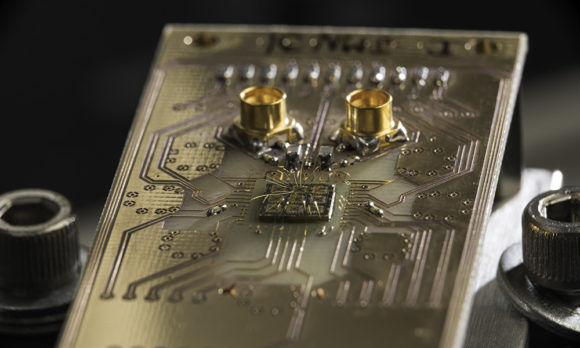|
|
|
|
 A quantum processor semiconductor chip is shown connected to a circuit board. (University of Rochester photo / J. Adam Fenster)
Researchers confront major hurdle in quantum computing In a series of papers published in Nature Communications, researchers at the University of Rochester, including John Nichol, an assistant professor of physics and astronomy, and graduate students Yadav Kandel and Haifeng Qiao, the lead authors of the papers, report major strides in enhancing quantum computing by improving the transfer of information between electrons in quantum systems.
A regular computer consists of billions of transistors, called bits. Quantum computers, on the other hand, are based on quantum bits, also known as qubits, which can be made from a single electron.
Unlike ordinary transistors, which can be either “0” (off) or “1” (on), qubits can be both “0” and “1” at the same time. The ability of individual qubits to occupy these so-called superposition states, where they are in multiple states simultaneously, underlies the great potential of quantum computers. Just like ordinary computers, however, quantum computers need a way to transfer quantum information between distant qubits—and that presents a major experimental challenge.
In one paper, the researchers demonstrated a route of transferring information between qubits, called adiabatic quantum state transfer (AQT), for the first time with electron-spin qubits. Unlike most methods of transferring information between qubits, which rely on carefully tuned electric or magnetic-field pulses, AQT isn’t as affected by pulse errors and noise.
In a second paper, the researchers demonstrated another technique of transferring information between qubits, using an exotic state of matter called time crystals. A time crystal is a strange state of matter in which interactions between the particles that make up the crystal can stabilize oscillations of the system in time indefinitely. Imagine a clock that keeps ticking forever; the pendulum of the clock oscillates in time, much like the oscillating time crystal.
Read more here.
Leukemia treatment can bait and capture cells in hidingThe latest method under investigation to attack leukemia is a bit like exterminating cockroaches: It’s a three-step process using cutting-edge technology to bait, trap, and kill leukemia cells at their root.
A paper published in Science Advances, led by Wilmot Cancer Institute researchers, describes the process and the significance for patients who face acute myeloid leukemia (AML), an aggressive type of blood cancer in which only 28 percent of people survive five years.
Although the research is early — it has only been tested in mice and in human cell cultures — it’s quite different from standard methods such as chemotherapy because it allows scientists to deliver treatment that can correct faulty genes that fuel the cancer, says Tzu-Chieh (Kate) Ho, the paper’s first author and a research assistant professor in hematology/oncology at Wilmot. Her mentor, Michael Becker, dean’s professor of hematology/oncology at Wilmot, is co-corresponding author.
Ho’s system to reach the root of leukemia uses CRISPR technology, which can edit genes inside a cell. In the article, she describes a novel way of baiting leukemia stem cells out of hiding, and then destroying them with a protein-RNA complex that enters the nucleus of the cancer cells and edits them so that they cannot survive. Read more here.
AS&E announces outstanding dissertationsThe AS&E Office of Graduate Education and Postdoctoral Affairs has announced these Outstanding Dissertations for 2020-2021:
- Jiangtao Gu, Visual and Cultural Studies
A Nation in Prospect: Photography and the Making of Modern China
- Philippe Lewalle, Physics
Quantum Trajectories and their Extremal–Probability Paths: New Phenomena and Applications
- Zuheir Desai, Political Science
Elections and Voting in Developing Democracies
- Georgios Alachouzos, Chemistry
Development of the Interrupted halo-Nazarov Reaction Methodology, Computational and Natural Product Synthesis Studies Towards Complex Halocyclopentenes
- Andrew Kless, History
Infighting at the Front: Officers, Bureaucrats, and Politicians at War in German-Occupied Russian Poland, 1914-1915
- Bochen Li, Electrical and Computer Engineering
Multi-modal Analysis for Music Performances
Dissertations are rated by a faculty panel on technical or creative strength, presentation, publication results, and impact of publications. The awardees each receive $1000.
Center of Excellence in Data Science offers funding to promote transfer of technology
Faculty members and other principal investigators interested in promoting the transfer of data science technology to New York companies can apply for funding of up to $60,000 from the University of Rochester Center of Excellence in Data Science.
Proposed projects must involve a NY industry partner and can span a broad range of data-science related technologies and domains. Ranking will be strongly dependent on the potential of the proposed project to generate economic impact. (More details here.)
Submit proposals by July 31 to Margaret Urzetta as attachments using the forms at www.sas.rochester.edu/dsc/coe/funding.html. Questions about the Center’s Collaborative Research Funding Program may be addressed to Center Director, Mujdat Cetin at mujdat.cetin@rochester.edu.
Community-based participatory research training offered
Keeping abreast of the University's response to COVID-19
Here are important links for researchers:
PLEASE NOTE that the University’s COVID-19 Dashboard is updated daily and dashboard numbers may reflect additional cases confirmed later in the day. When a new case is known, the contact-tracing process begins immediately with the Monroe County Health Department, with confirmed exposures being contacted and required to quarantine. Remember:
If you feel like you’re experiencing any COVID-19 symptoms, it’s best to report them through Dr. Chat Bot immediately. Even if you think your symptoms might be something else, like a cold, seasonal congestion, or allergies, it’s still important to tell University health professionals and contact tracers what you are experiencing—they always want to receive more, not less, information.
Common COVID-19 symptoms include:
- A temperature of 100 °F (37.8 °C) or higher
- Chills
- Muscle or body aches
- Severe fatigue
- Headache
- Congestion or runny nose
- Sore throat
- Loss of taste, smell, or appetite
- Cough, shortness of breath, or difficulty breathing
- Nausea, vomiting, or diarrhea
|
|
|
|
|